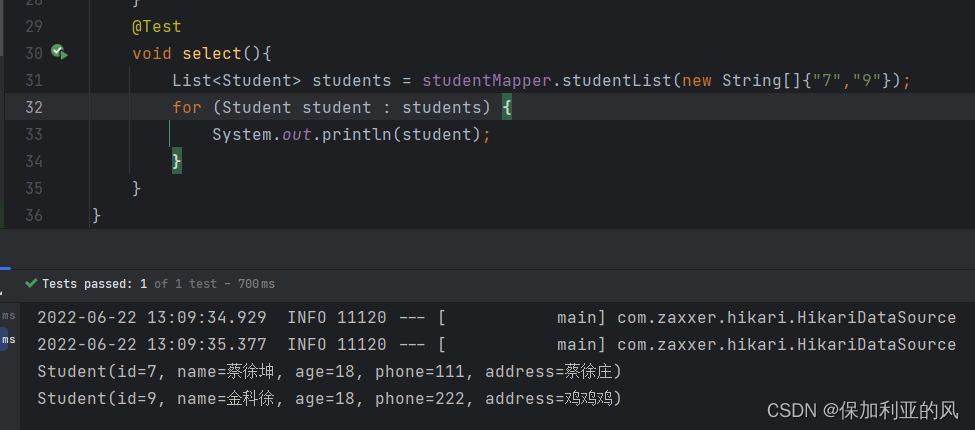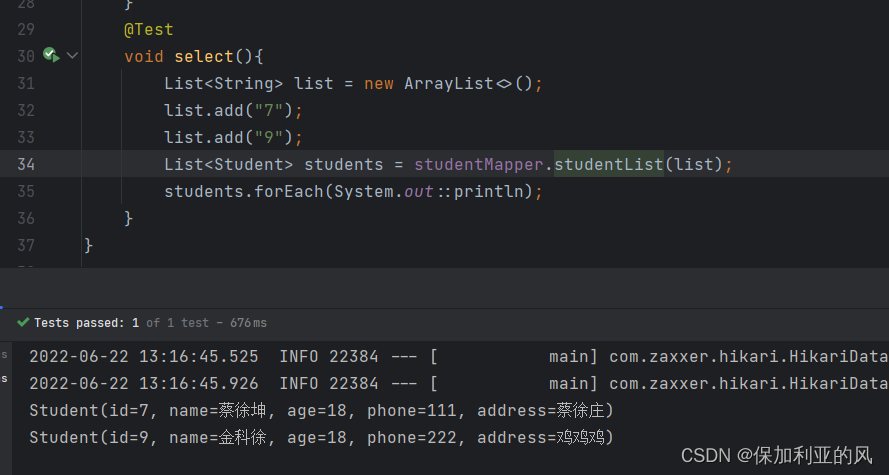在关系型数据库中,IN条件查询是一种常见的查询方式,它允许我们在SQL语句中指定一个值列表,并返回匹配这些值的记录。MyBatis作为一款优秀的持久层框架,提供了灵活且高效的API来实现IN条件查询。通过使用MyBatis的动态SQL和参数映射功能,我们可以轻松地构建复杂的查询语句,满足各种业务需求。本文将详细介绍如何在MyBatis中使用IN条件查询,帮助读者掌握这一关键技术。
这篇文章我会演示几种mybatis中使用in查询的方式。
1 数组、字符串
2 集合
3 使用Myabtis-plus框架的条件构造器来实现
我们在mysql中使用in查询的方式是这样的

那在mybatis中我们使用<foreach>标签来实现包含查询
1 使用数组方式
Mapper:

Mapper.xml:
<select id="studentList" resultType="com.ywt.springboot.model.Student">
select *
from student
where id in
<foreach collection="array" index="index" item="item" open="(" separator="," close=")">
#{item}
</foreach>
</select>注:foreach中的 collection标签中为array,item是遍历ids中的每个元素,默认为item可以自定义。
测试类:

我们可以使用字符串来接收参数,使用逗号分隔每个参数,然后把分隔后的参数放到集合中。

2 使用List集合的方式
Mapper:

Mapper.xml
<select id="studentList" resultType="com.ywt.springboot.model.Student">
select *
from student
where id in
<foreach collection="list" index="index" item="item" open="(" separator="," close=")">
#{item}
</foreach>
</select>使用list方式collection的value必须为list
测试:

3 第三种我们使用Mybatis-plus框架的条件构造器来进行查询
@Test
void Test(){
QueryWrapper<Student> qw = new QueryWrapper<>();
qw.in("id",7,9);
List<Student> students = studentMapper.selectList(qw);
System.out.println(students.toString());
}测试结果:
[Student(id=7, name=蔡徐坤, age=18), Student(id=9, name=金科徐, age=18)]
附:Mybatis-plus的条件构造器详细使用教程
常用函数:
| 函数 | 说明 | 例子(以下为where后的条件,select * from user where ?) |
|---|---|---|
| eq | 等于= | eq("name","张三") --> name = '张三' |
| ne | 不等于 != | ne("name","李四") --> name != '李四' |
| gt | 大于 > | gt(age,18) --> age > 18 //年龄大于18岁 |
| ge | 大于等于 >= | ge(age,18) --> age >=18 |
| lt | 小于 < | lt(age,20) --> age < 20 //年龄小于20岁 |
| le | 小于等于 <= | le(age,20) ---> age <= 20 |
| between | between 值1 and 值2 | between(age,15,25) ---> 匹配15岁到25岁之间(包含15和25) |
| nobetween | not between 值1 and 值2 | notBetween(age,35,45)-->匹配不包含35-45之间的(包含35和45) |
| like | like '%值%' | like("name","张") --> like '%张%' |
| notlike | not like '%值%' | notLike("name”,"张") --> not like '%张%' |
| likeLeft | like '%值' | likeLeft("name","王") ---> like "%王" |
| likeRight | like '值%' | likeRight("name","王") ---> like "王%" |
| isNull | 表字段 is NULL | isNull("name") ---> name is null |
| notNull | 表字段 is not NULL | isNull("name") ---> name is not null |
| in | 表字段in(v1,v2,v3...) | in("num",{1,2,3}) ---> num in (1,2,3) |
| notIn | 表字段 not in(v1.v2,v3) | notIn("num",{2,3,4}) ---> num not in (2,3,4) |
使用构造器完成一个简单的查询
// SQL语句:select * from user where id = ?
// 使用条件构造器QueryWrapper
@Test
void queryWrapper(){
QueryWrapper<User> qw = new QueryWrapper<>();
qw.eq("id",1);
List<User> users = userMapper.selectList(qw);
users.forEach(System.out::print);
}那么再来一点更多条件的
// 我们要查询name里姓氏包含 ‘张',并且年龄小于30岁的
// SQL语句:select * from user where name like '张%' and age < 30
// 条件构造器:
@Test
void queryWrapper(){
QueryWrapper<User> qw = new QueryWrapper<>();
qw.likeRight("name","张").lt("age","30");
List<User> users = userMapper.selectList(qw);
users.forEach(System.out::println);
}// 查询出年龄在15-25之间,并且他的名字不为空
// SQL语句:select * from user where name is not null and age between(15,25)
//条件构造器
@Test
void queryWrapper(){
QueryWrapper<User> qw = new QueryWrapper<>();
qw.isNotNull("name").between("age",18,25);
List<User> users = userMapper.selectList(qw);
users.forEach(System.out::println);
}// 查询名字中带有王的,并且年龄不小于30,邮箱为空的
// SQL语句:select * from user where name like '%王%' and age >= 30 and email is null
// 条件构造器:
@Test
void queryWrapper(){
QueryWrapper<User> qw = new QueryWrapper<>();
qw.like("name","王").ge("age",30).isNull("email");
List<User> users = userMapper.selectList(qw);
users.forEach(System.out::println);
}总结
通过本文的介绍,我们掌握了如何在MyBatis中使用IN条件查询。通过动态SQL和参数映射功能,我们可以灵活地构建包含IN条件的查询语句,并高效地执行数据库查询操作。无论是在简单的单表查询还是复杂的多表联查中,IN条件查询都是一种非常实用的技术。希望本文的内容能够帮助大家更好地理解和应用MyBatis,提升数据库操作的效率和灵活性。
本文来源于#保加利亚的风,由@蜜芽 整理发布。如若内容造成侵权/违法违规/事实不符,请联系本站客服处理!
该文章观点仅代表作者本人,不代表本站立场。本站不承担相关法律责任。
如若转载,请注明出处:https://www.zhanid.com/biancheng/2734.html


















